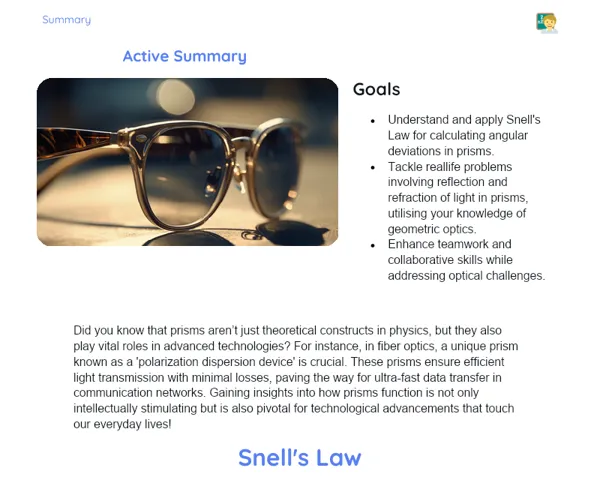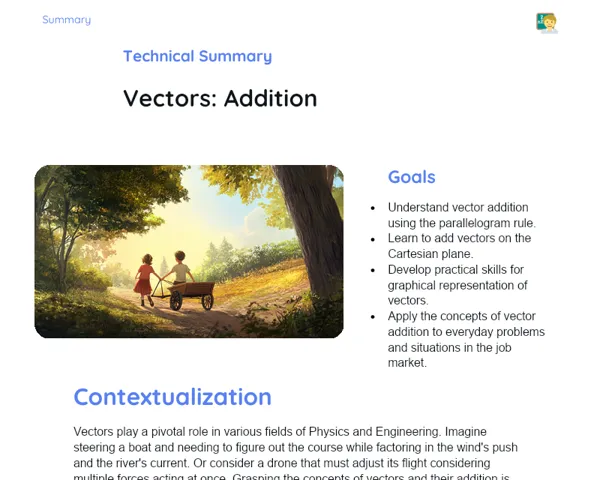Objectives
1. 🔍 Understand how to use graphs to calculate the work done by a force, recognizing that the area under the curve in a force versus displacement graph is numerically equivalent to the work done by the force.
2. 📊 Develop skills for analyzing and interpreting graphs, which are essential for applying physical concepts not just in class, but in real-life situations and day-to-day problems.
3. ⚙️ Apply the knowledge gained to solve practical and theoretical problems that involve calculating work across various scenarios.
Contextualization
Did you know that the same logic used to calculate work done by a force in physics is also used in fields like engineering and economics? For instance, engineers employ this technique to optimise the design of machines and structures, while economists can evaluate the 'work' or effort required to achieve specific economic tasks. This shows how important and versatile the concepts of work and graphs are, not just in science, but in many aspects of our everyday lives.
Important Topics
Force and Displacement
In physics, force is a vector that can alter the state of motion of an object. When a force acts on an object and causes it to move, we say that work has been done. Displacement refers to an object's change in position relative to a reference point. Force and displacement are fundamental for calculating work, and their relationship can be depicted in a force versus displacement graph.
-
Force is a vector quantity that has both direction and magnitude. In the context of work, the direction of the force and displacement must align for the work to be proportional to the product of these two.
-
Displacement is the distance moved in the direction of the applied force. When a force is applied at an angle to the displacement, only the component of the force in the direction of the displacement is considered when calculating work.
-
The area under the curve in a force versus displacement graph corresponds numerically to the work done by the force. This concept is key to understanding how graphs can be used to analyse and calculate work in practical situations.
Calculating and Interpreting Area in Graphs
When plotting a force versus displacement graph, the area underneath the curve represents the work done by the force. This approach is fundamental for understanding how graphs can be used not just to visualise but also to compute physical quantities. Correct interpretation of the area under the curve in various types of graphs is a vital skill for solving physics and other scientific problems.
-
The area under the curve of a force versus displacement graph is calculated by breaking it into familiar shapes (like rectangles and trapezoids) and summing their areas.
-
Correctly interpreting the area under the curve is crucial for accurate work calculation, especially when the force varies and the graph might consist of curves or segments.
-
This technique for area calculation isn't confined to force and displacement graphs; in fields like economics and biology, the ability to derive and interpret areas in graphs is essential for analysis and decision-making.
Practical Applications of Work Graphs
Using graphs to calculate work isn't just theoretical; it has significant real-world applications. Engineers, for instance, leverage this technique to improve the performance of machines and structures, while sports professionals may use these concepts to enhance training regimens. Understanding how graphs apply in real-life situations enriches the learning experience and highlights the relevance of physics in everyday life.
-
Engineers apply work graphs to optimise machines that convert mechanical energy to electrical energy or vice versa, such as generators and motors.
-
Athletes and coaches use graphs to assess the work done in training and competitions, adjusting strategies based on the areas under the curves of effort versus time graphs.
-
A practical grasp of work graphs can assist in resolving everyday issues, such as optimising delivery routes to minimise the work done by vehicles.
Key Terms
-
Work (in Physics): The product of the force applied over a displacement in the direction of that force.
-
Force (in Physics): A vector quantity that can influence an object's motion.
-
Displacement (in Physics): The change in position of an object with respect to a reference point.
-
Area under the Curve: In graphing, this numerically represents physical quantities, like the work done by the force in a force versus displacement graph.
For Reflection
-
How can grasping and applying the concepts of work and graphs benefit you in daily life, beyond the classroom?
-
In what ways can digital technologies and visualisation software enhance the analysis of work graphs in real-world scenarios such as engineering or sports?
-
Why is it critical to consider the direction and angle between the force and displacement when calculating work, and how does this phenomenon play out in real-life situations you might encounter?
Important Conclusions
-
We reviewed how force, displacement, and the area under the curve of a graph closely relate to the concept of work in physics. The practical application of these concepts extends beyond the lab, proving crucial in fields like engineering, economics, and sports.
-
The ability to interpret and calculate the area under a force versus displacement graph enables us to understand and predict the behaviour of mechanical and biological systems, alongside optimising processes in everyday life.
-
We also discussed how leveraging digital technologies and software can streamline the analysis of complex graphs, making physics more accessible and applicable across various real-world situations.
To Exercise Knowledge
To reinforce your understanding, try the following exercise: Use a drawing app or spreadsheet software to plot a force versus displacement graph for an object moving under the influence of a constant force. Calculate the work done by plotting the graph and measuring the area under the curve. Share your findings and challenges in our next virtual meeting!
Challenge
Graph Poster Challenge: Create an engaging poster explaining the concept of work in physics using colourful graphs and relatable examples. Include at least three different scenarios where work is calculated and present your results with clear and comprehensible graphs. This challenge will aid you in articulating theory and practice in a creative and informative manner!
Study Tips
-
Practice creating and interpreting graphs in real-life situations. For example, when planning a cycling trip, consider the force you exert on the pedals and how it correlates with displacement.
-
Utilise online resources like physics simulators to visualise and manipulate work graphs in various scenarios, which can help solidify your theoretical understanding.
-
Form study groups to discuss and solve problems connected to work graphs. Teaching what you’ve learned to peers is an effective way to reinforce your own knowledge.



